Analysis of Management Accounting Strategies: Coffeegreen and Galaxy
VerifiedAdded on 2021/11/19
|21
|4926
|36
Report
AI Summary
This report provides a detailed analysis of the management accounting practices of two companies, Coffeegreen and Galaxy, focusing on their financial data and decision-making processes. The report examines various planning tools like standard costs, budgets, and the balanced scorecard, evaluating their advantages and disadvantages. It includes calculations for contract costs, standard costs, and revenue maximization, along with a comprehensive monthly budget analysis for sales revenue, production volume, and resource costs. Furthermore, the report addresses cost variances and provides recommendations for improvement, including employee compensation and training. Finally, the report analyzes the PEST factors affecting the companies' operations.
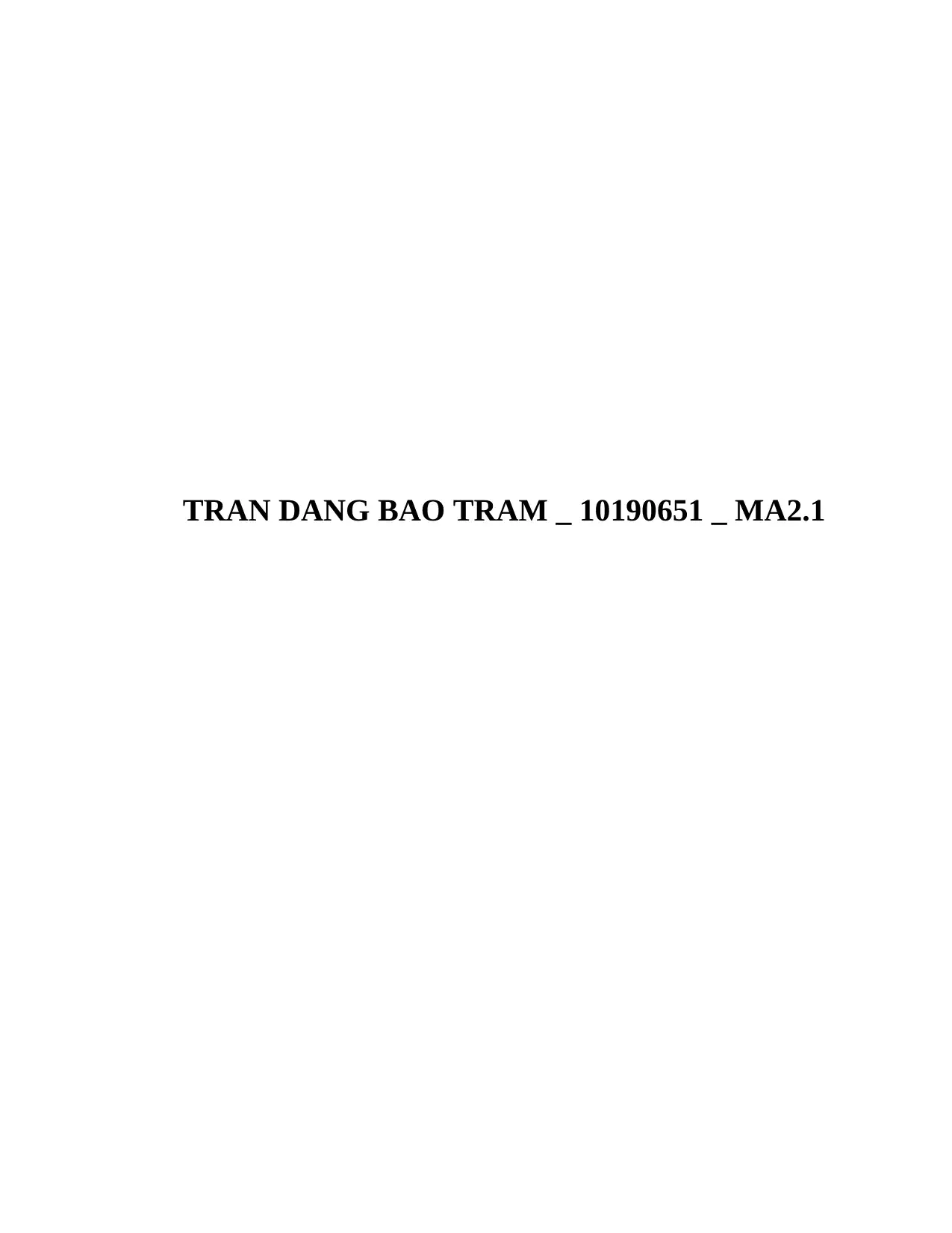
TRAN DANG BAO TRAM _ 10190651 _ MA2.1
Paraphrase This Document
Need a fresh take? Get an instant paraphrase of this document with our AI Paraphraser
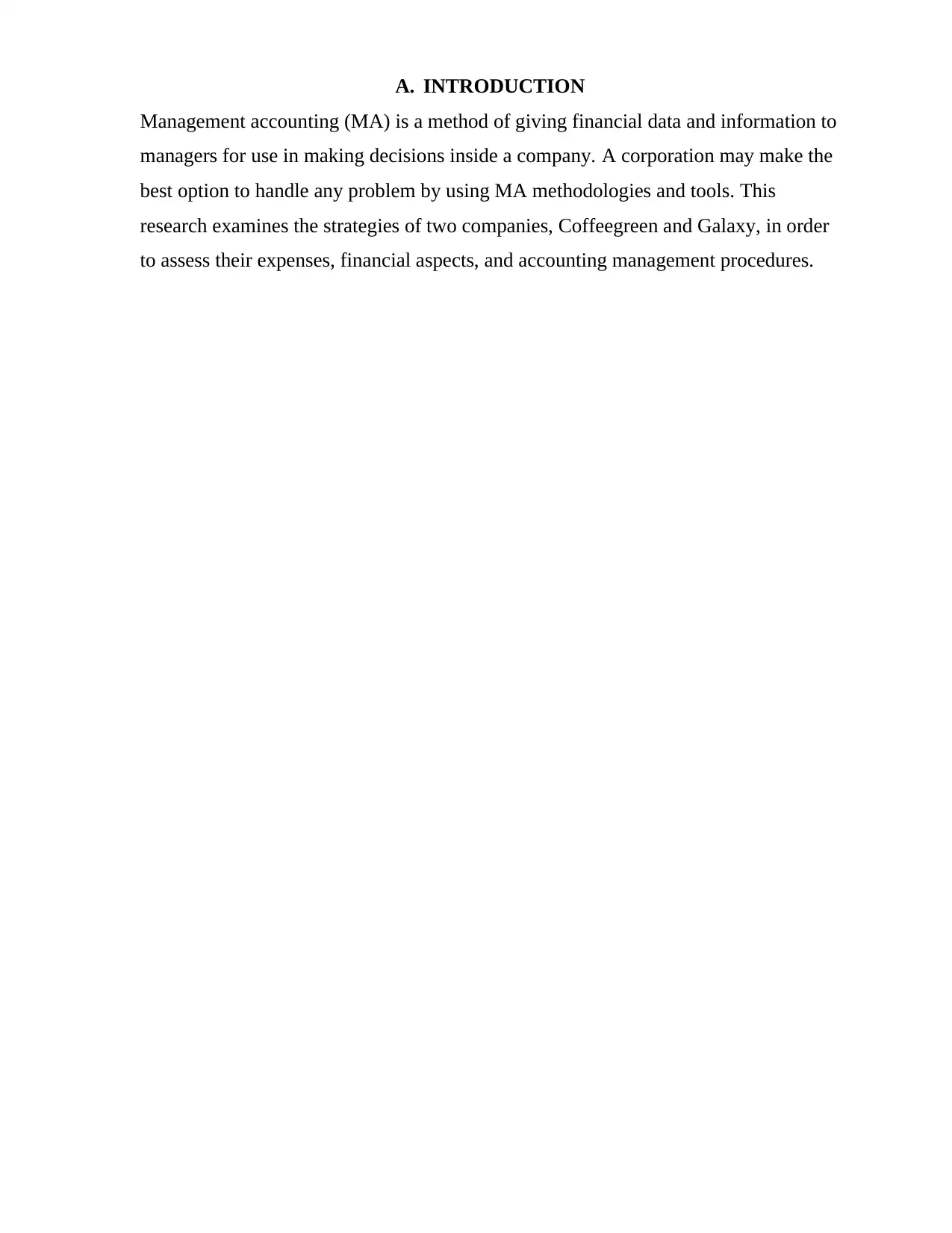
A. INTRODUCTION
Management accounting (MA) is a method of giving financial data and information to
managers for use in making decisions inside a company. A corporation may make the
best option to handle any problem by using MA methodologies and tools. This
research examines the strategies of two companies, Coffeegreen and Galaxy, in order
to assess their expenses, financial aspects, and accounting management procedures.
Management accounting (MA) is a method of giving financial data and information to
managers for use in making decisions inside a company. A corporation may make the
best option to handle any problem by using MA methodologies and tools. This
research examines the strategies of two companies, Coffeegreen and Galaxy, in order
to assess their expenses, financial aspects, and accounting management procedures.
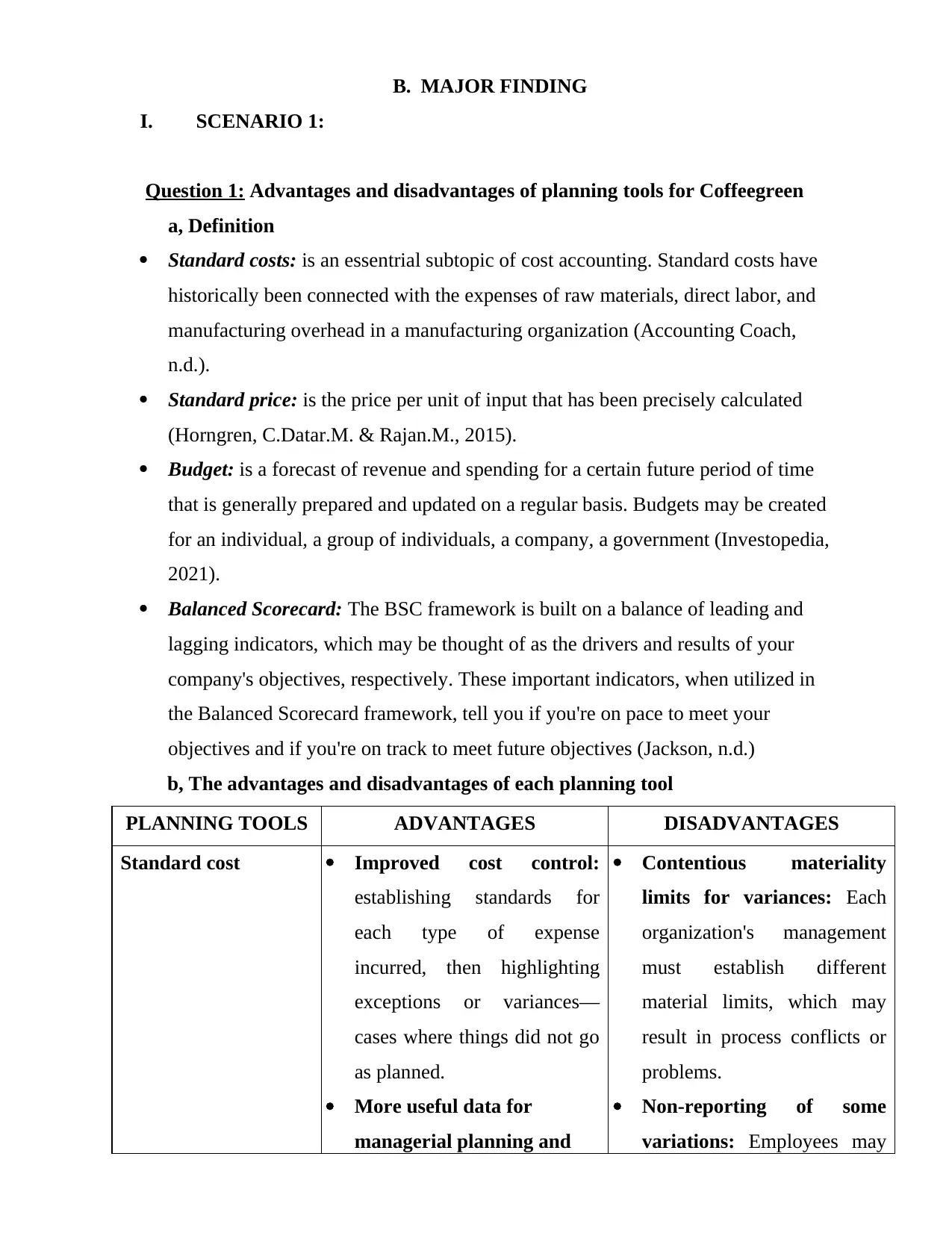
B. MAJOR FINDING
I. SCENARIO 1:
Question 1: Advantages and disadvantages of planning tools for Coffeegreen
a, Definition
Standard costs: is an essentrial subtopic of cost accounting. Standard costs have
historically been connected with the expenses of raw materials, direct labor, and
manufacturing overhead in a manufacturing organization (Accounting Coach,
n.d.).
Standard price: is the price per unit of input that has been precisely calculated
(Horngren, C.Datar.M. & Rajan.M., 2015).
Budget: is a forecast of revenue and spending for a certain future period of time
that is generally prepared and updated on a regular basis. Budgets may be created
for an individual, a group of individuals, a company, a government (Investopedia,
2021).
Balanced Scorecard: The BSC framework is built on a balance of leading and
lagging indicators, which may be thought of as the drivers and results of your
company's objectives, respectively. These important indicators, when utilized in
the Balanced Scorecard framework, tell you if you're on pace to meet your
objectives and if you're on track to meet future objectives (Jackson, n.d.)
b, The advantages and disadvantages of each planning tool
PLANNING TOOLS ADVANTAGES DISADVANTAGES
Standard cost Improved cost control:
establishing standards for
each type of expense
incurred, then highlighting
exceptions or variances—
cases where things did not go
as planned.
More useful data for
managerial planning and
Contentious materiality
limits for variances: Each
organization's management
must establish different
material limits, which may
result in process conflicts or
problems.
Non-reporting of some
variations: Employees may
I. SCENARIO 1:
Question 1: Advantages and disadvantages of planning tools for Coffeegreen
a, Definition
Standard costs: is an essentrial subtopic of cost accounting. Standard costs have
historically been connected with the expenses of raw materials, direct labor, and
manufacturing overhead in a manufacturing organization (Accounting Coach,
n.d.).
Standard price: is the price per unit of input that has been precisely calculated
(Horngren, C.Datar.M. & Rajan.M., 2015).
Budget: is a forecast of revenue and spending for a certain future period of time
that is generally prepared and updated on a regular basis. Budgets may be created
for an individual, a group of individuals, a company, a government (Investopedia,
2021).
Balanced Scorecard: The BSC framework is built on a balance of leading and
lagging indicators, which may be thought of as the drivers and results of your
company's objectives, respectively. These important indicators, when utilized in
the Balanced Scorecard framework, tell you if you're on pace to meet your
objectives and if you're on track to meet future objectives (Jackson, n.d.)
b, The advantages and disadvantages of each planning tool
PLANNING TOOLS ADVANTAGES DISADVANTAGES
Standard cost Improved cost control:
establishing standards for
each type of expense
incurred, then highlighting
exceptions or variances—
cases where things did not go
as planned.
More useful data for
managerial planning and
Contentious materiality
limits for variances: Each
organization's management
must establish different
material limits, which may
result in process conflicts or
problems.
Non-reporting of some
variations: Employees may
⊘ This is a preview!⊘
Do you want full access?
Subscribe today to unlock all pages.

Trusted by 1+ million students worldwide
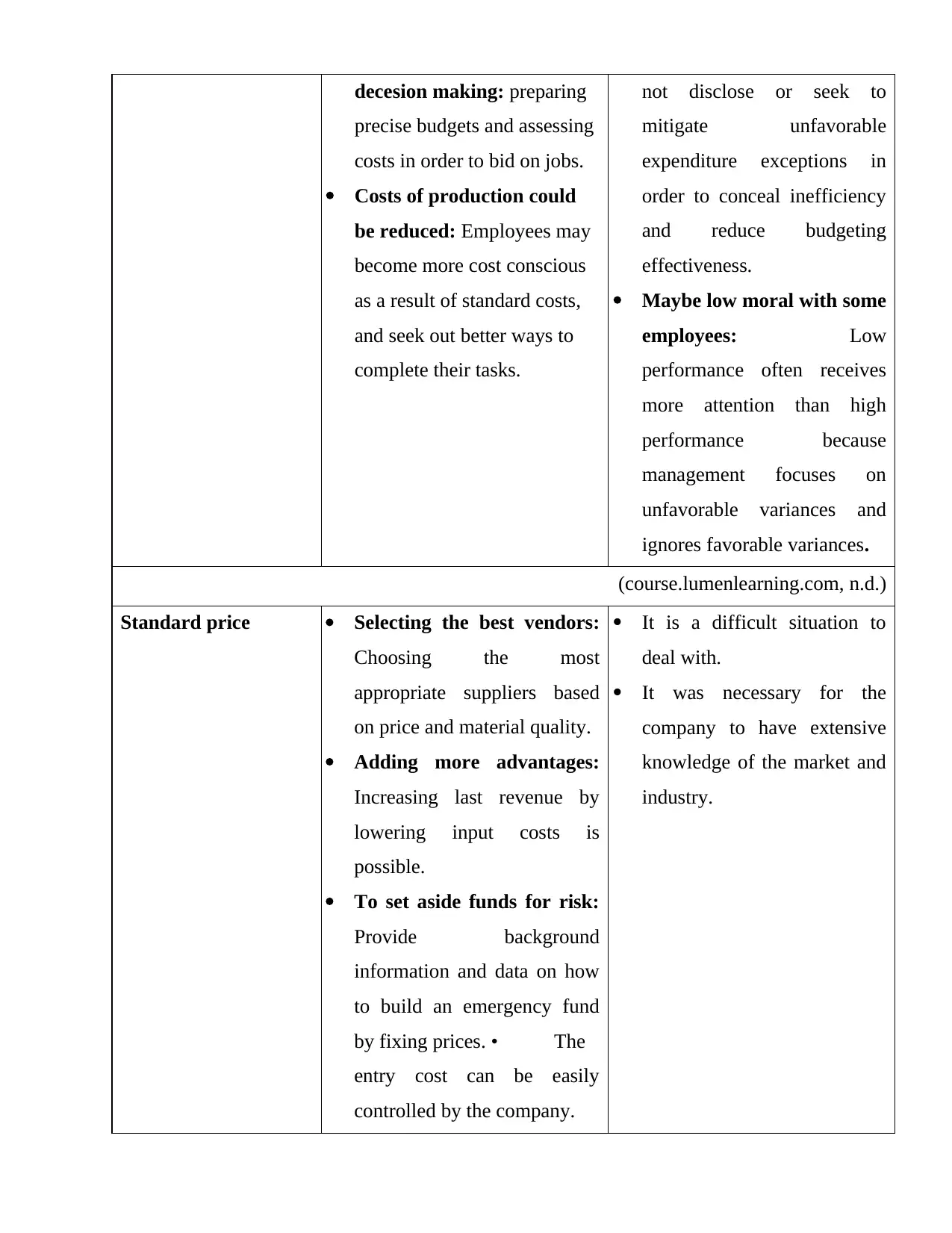
decesion making: preparing
precise budgets and assessing
costs in order to bid on jobs.
Costs of production could
be reduced: Employees may
become more cost conscious
as a result of standard costs,
and seek out better ways to
complete their tasks.
not disclose or seek to
mitigate unfavorable
expenditure exceptions in
order to conceal inefficiency
and reduce budgeting
effectiveness.
Maybe low moral with some
employees: Low
performance often receives
more attention than high
performance because
management focuses on
unfavorable variances and
ignores favorable variances.
(course.lumenlearning.com, n.d.)
Standard price Selecting the best vendors:
Choosing the most
appropriate suppliers based
on price and material quality.
Adding more advantages:
Increasing last revenue by
lowering input costs is
possible.
To set aside funds for risk:
Provide background
information and data on how
to build an emergency fund
by fixing prices. • The
entry cost can be easily
controlled by the company.
It is a difficult situation to
deal with.
It was necessary for the
company to have extensive
knowledge of the market and
industry.
precise budgets and assessing
costs in order to bid on jobs.
Costs of production could
be reduced: Employees may
become more cost conscious
as a result of standard costs,
and seek out better ways to
complete their tasks.
not disclose or seek to
mitigate unfavorable
expenditure exceptions in
order to conceal inefficiency
and reduce budgeting
effectiveness.
Maybe low moral with some
employees: Low
performance often receives
more attention than high
performance because
management focuses on
unfavorable variances and
ignores favorable variances.
(course.lumenlearning.com, n.d.)
Standard price Selecting the best vendors:
Choosing the most
appropriate suppliers based
on price and material quality.
Adding more advantages:
Increasing last revenue by
lowering input costs is
possible.
To set aside funds for risk:
Provide background
information and data on how
to build an emergency fund
by fixing prices. • The
entry cost can be easily
controlled by the company.
It is a difficult situation to
deal with.
It was necessary for the
company to have extensive
knowledge of the market and
industry.
Paraphrase This Document
Need a fresh take? Get an instant paraphrase of this document with our AI Paraphraser
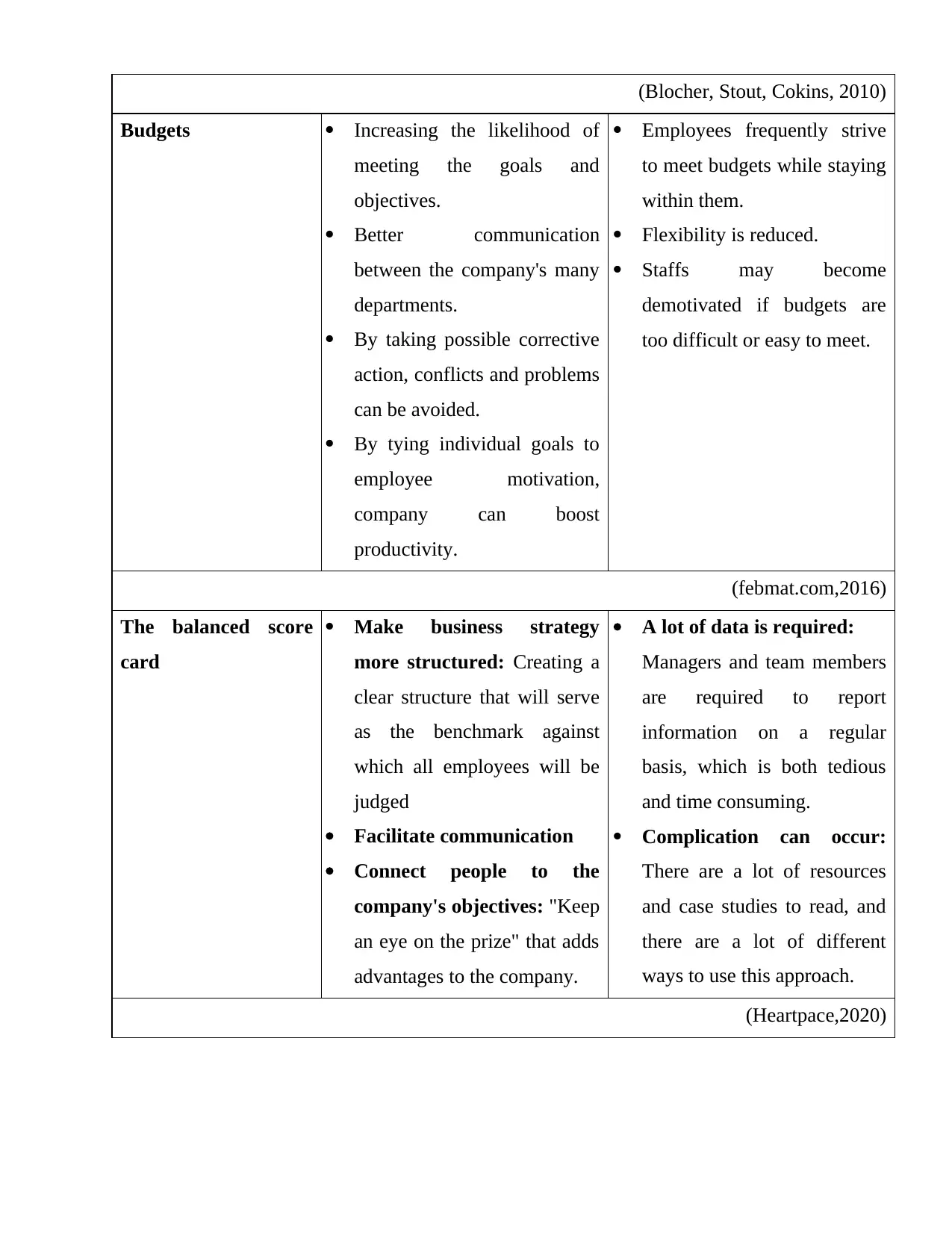
(Blocher, Stout, Cokins, 2010)
Budgets Increasing the likelihood of
meeting the goals and
objectives.
Better communication
between the company's many
departments.
By taking possible corrective
action, conflicts and problems
can be avoided.
By tying individual goals to
employee motivation,
company can boost
productivity.
Employees frequently strive
to meet budgets while staying
within them.
Flexibility is reduced.
Staffs may become
demotivated if budgets are
too difficult or easy to meet.
(febmat.com,2016)
The balanced score
card
Make business strategy
more structured: Creating a
clear structure that will serve
as the benchmark against
which all employees will be
judged
Facilitate communication
Connect people to the
company's objectives: "Keep
an eye on the prize" that adds
advantages to the company.
A lot of data is required:
Managers and team members
are required to report
information on a regular
basis, which is both tedious
and time consuming.
Complication can occur:
There are a lot of resources
and case studies to read, and
there are a lot of different
ways to use this approach.
(Heartpace,2020)
Budgets Increasing the likelihood of
meeting the goals and
objectives.
Better communication
between the company's many
departments.
By taking possible corrective
action, conflicts and problems
can be avoided.
By tying individual goals to
employee motivation,
company can boost
productivity.
Employees frequently strive
to meet budgets while staying
within them.
Flexibility is reduced.
Staffs may become
demotivated if budgets are
too difficult or easy to meet.
(febmat.com,2016)
The balanced score
card
Make business strategy
more structured: Creating a
clear structure that will serve
as the benchmark against
which all employees will be
judged
Facilitate communication
Connect people to the
company's objectives: "Keep
an eye on the prize" that adds
advantages to the company.
A lot of data is required:
Managers and team members
are required to report
information on a regular
basis, which is both tedious
and time consuming.
Complication can occur:
There are a lot of resources
and case studies to read, and
there are a lot of different
ways to use this approach.
(Heartpace,2020)
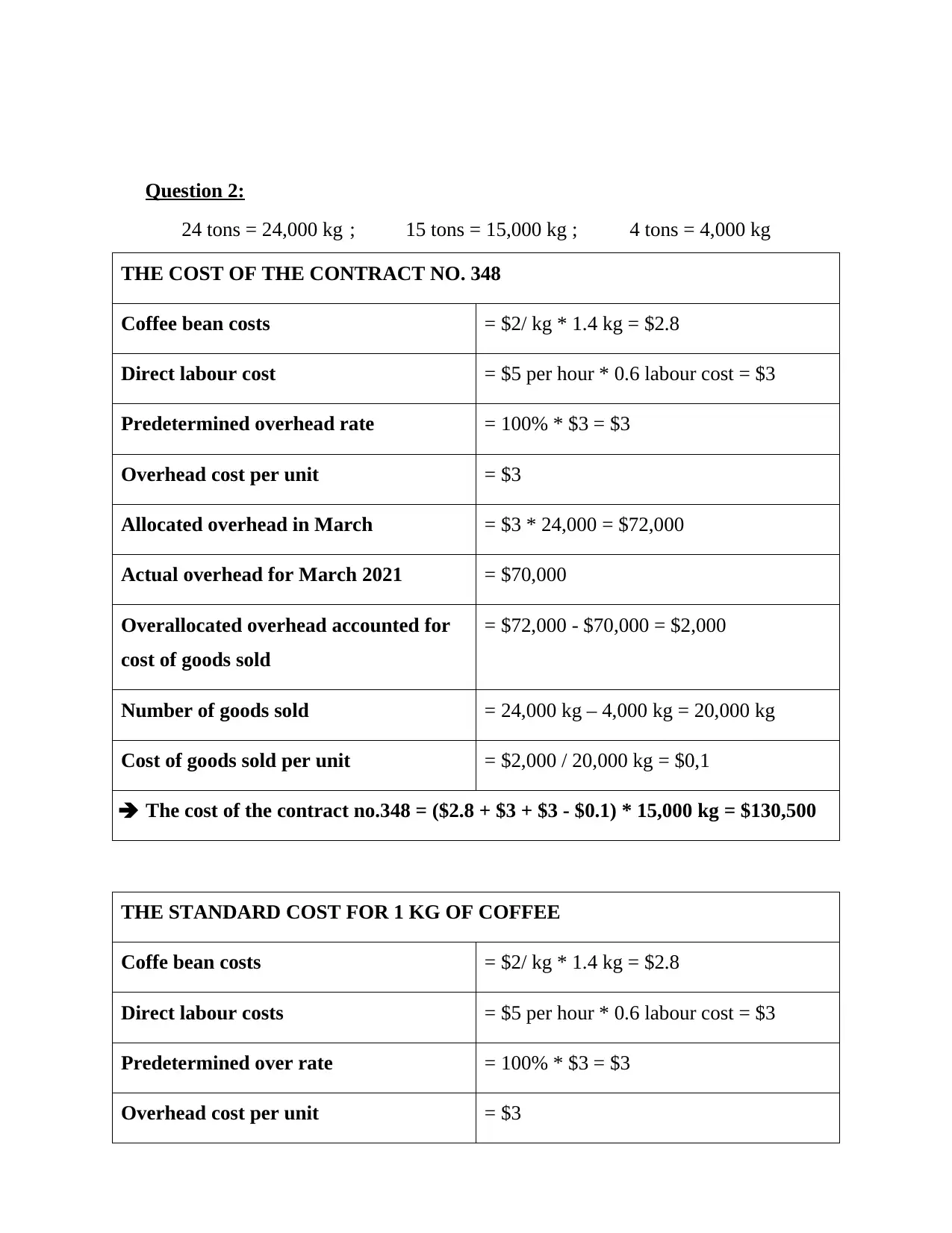
Question 2:
24 tons = 24,000 kg ; 15 tons = 15,000 kg ; 4 tons = 4,000 kg
THE COST OF THE CONTRACT NO. 348
Coffee bean costs = $2/ kg * 1.4 kg = $2.8
Direct labour cost = $5 per hour * 0.6 labour cost = $3
Predetermined overhead rate = 100% * $3 = $3
Overhead cost per unit = $3
Allocated overhead in March = $3 * 24,000 = $72,000
Actual overhead for March 2021 = $70,000
Overallocated overhead accounted for
cost of goods sold
= $72,000 - $70,000 = $2,000
Number of goods sold = 24,000 kg – 4,000 kg = 20,000 kg
Cost of goods sold per unit = $2,000 / 20,000 kg = $0,1
The cost of the contract no.348 = ($2.8 + $3 + $3 - $0.1) * 15,000 kg = $130,500
THE STANDARD COST FOR 1 KG OF COFFEE
Coffe bean costs = $2/ kg * 1.4 kg = $2.8
Direct labour costs = $5 per hour * 0.6 labour cost = $3
Predetermined over rate = 100% * $3 = $3
Overhead cost per unit = $3
24 tons = 24,000 kg ; 15 tons = 15,000 kg ; 4 tons = 4,000 kg
THE COST OF THE CONTRACT NO. 348
Coffee bean costs = $2/ kg * 1.4 kg = $2.8
Direct labour cost = $5 per hour * 0.6 labour cost = $3
Predetermined overhead rate = 100% * $3 = $3
Overhead cost per unit = $3
Allocated overhead in March = $3 * 24,000 = $72,000
Actual overhead for March 2021 = $70,000
Overallocated overhead accounted for
cost of goods sold
= $72,000 - $70,000 = $2,000
Number of goods sold = 24,000 kg – 4,000 kg = 20,000 kg
Cost of goods sold per unit = $2,000 / 20,000 kg = $0,1
The cost of the contract no.348 = ($2.8 + $3 + $3 - $0.1) * 15,000 kg = $130,500
THE STANDARD COST FOR 1 KG OF COFFEE
Coffe bean costs = $2/ kg * 1.4 kg = $2.8
Direct labour costs = $5 per hour * 0.6 labour cost = $3
Predetermined over rate = 100% * $3 = $3
Overhead cost per unit = $3
⊘ This is a preview!⊘
Do you want full access?
Subscribe today to unlock all pages.

Trusted by 1+ million students worldwide
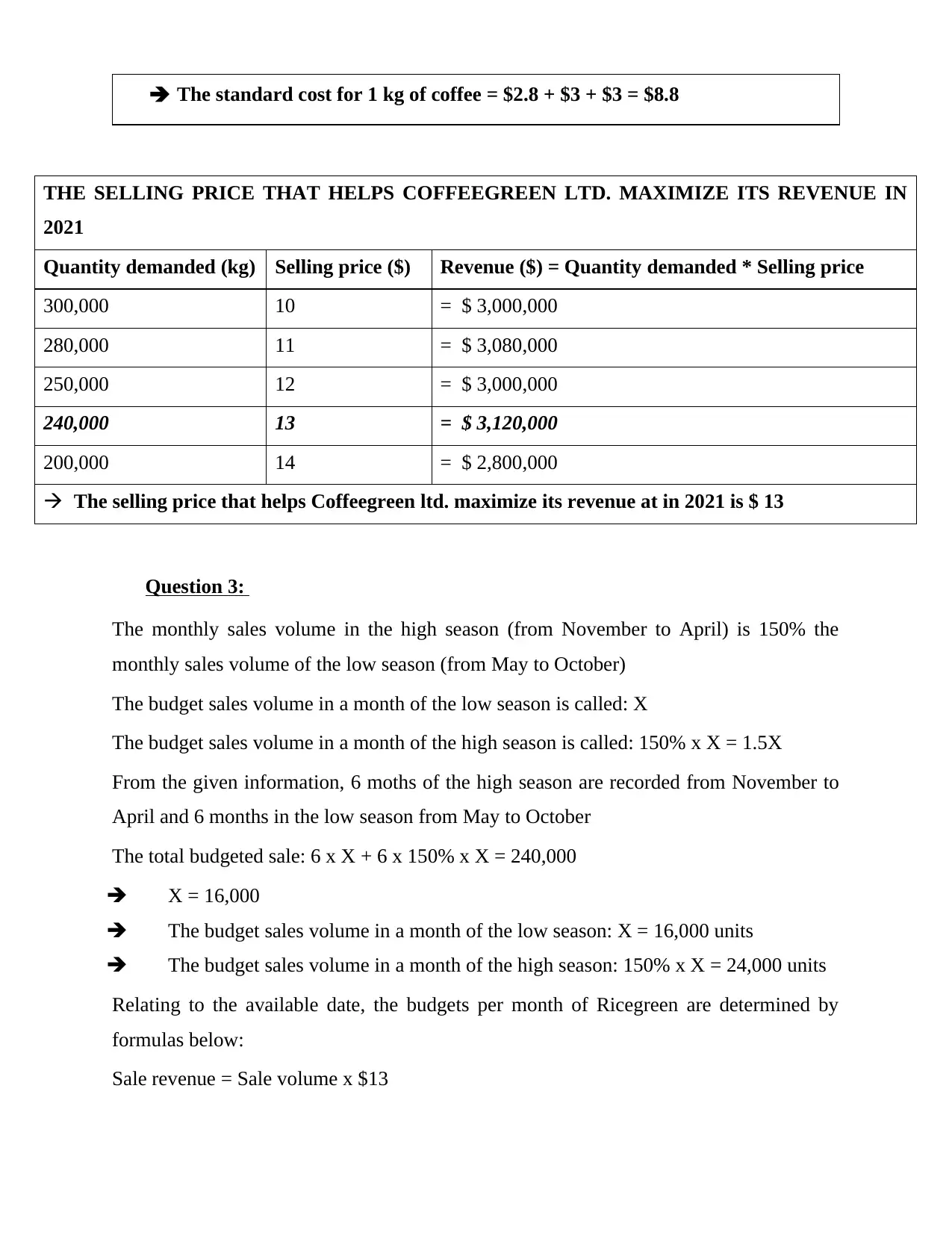
The standard cost for 1 kg of coffee = $2.8 + $3 + $3 = $8.8
THE SELLING PRICE THAT HELPS COFFEEGREEN LTD. MAXIMIZE ITS REVENUE IN
2021
Quantity demanded (kg) Selling price ($) Revenue ($) = Quantity demanded * Selling price
300,000 10 = $ 3,000,000
280,000 11 = $ 3,080,000
250,000 12 = $ 3,000,000
240,000 13 = $ 3,120,000
200,000 14 = $ 2,800,000
The selling price that helps Coffeegreen ltd. maximize its revenue at in 2021 is $ 13
Question 3:
The monthly sales volume in the high season (from November to April) is 150% the
monthly sales volume of the low season (from May to October)
The budget sales volume in a month of the low season is called: X
The budget sales volume in a month of the high season is called: 150% x X = 1.5X
From the given information, 6 moths of the high season are recorded from November to
April and 6 months in the low season from May to October
The total budgeted sale: 6 x X + 6 x 150% x X = 240,000
X = 16,000
The budget sales volume in a month of the low season: X = 16,000 units
The budget sales volume in a month of the high season: 150% x X = 24,000 units
Relating to the available date, the budgets per month of Ricegreen are determined by
formulas below:
Sale revenue = Sale volume x $13
THE SELLING PRICE THAT HELPS COFFEEGREEN LTD. MAXIMIZE ITS REVENUE IN
2021
Quantity demanded (kg) Selling price ($) Revenue ($) = Quantity demanded * Selling price
300,000 10 = $ 3,000,000
280,000 11 = $ 3,080,000
250,000 12 = $ 3,000,000
240,000 13 = $ 3,120,000
200,000 14 = $ 2,800,000
The selling price that helps Coffeegreen ltd. maximize its revenue at in 2021 is $ 13
Question 3:
The monthly sales volume in the high season (from November to April) is 150% the
monthly sales volume of the low season (from May to October)
The budget sales volume in a month of the low season is called: X
The budget sales volume in a month of the high season is called: 150% x X = 1.5X
From the given information, 6 moths of the high season are recorded from November to
April and 6 months in the low season from May to October
The total budgeted sale: 6 x X + 6 x 150% x X = 240,000
X = 16,000
The budget sales volume in a month of the low season: X = 16,000 units
The budget sales volume in a month of the high season: 150% x X = 24,000 units
Relating to the available date, the budgets per month of Ricegreen are determined by
formulas below:
Sale revenue = Sale volume x $13
Paraphrase This Document
Need a fresh take? Get an instant paraphrase of this document with our AI Paraphraser
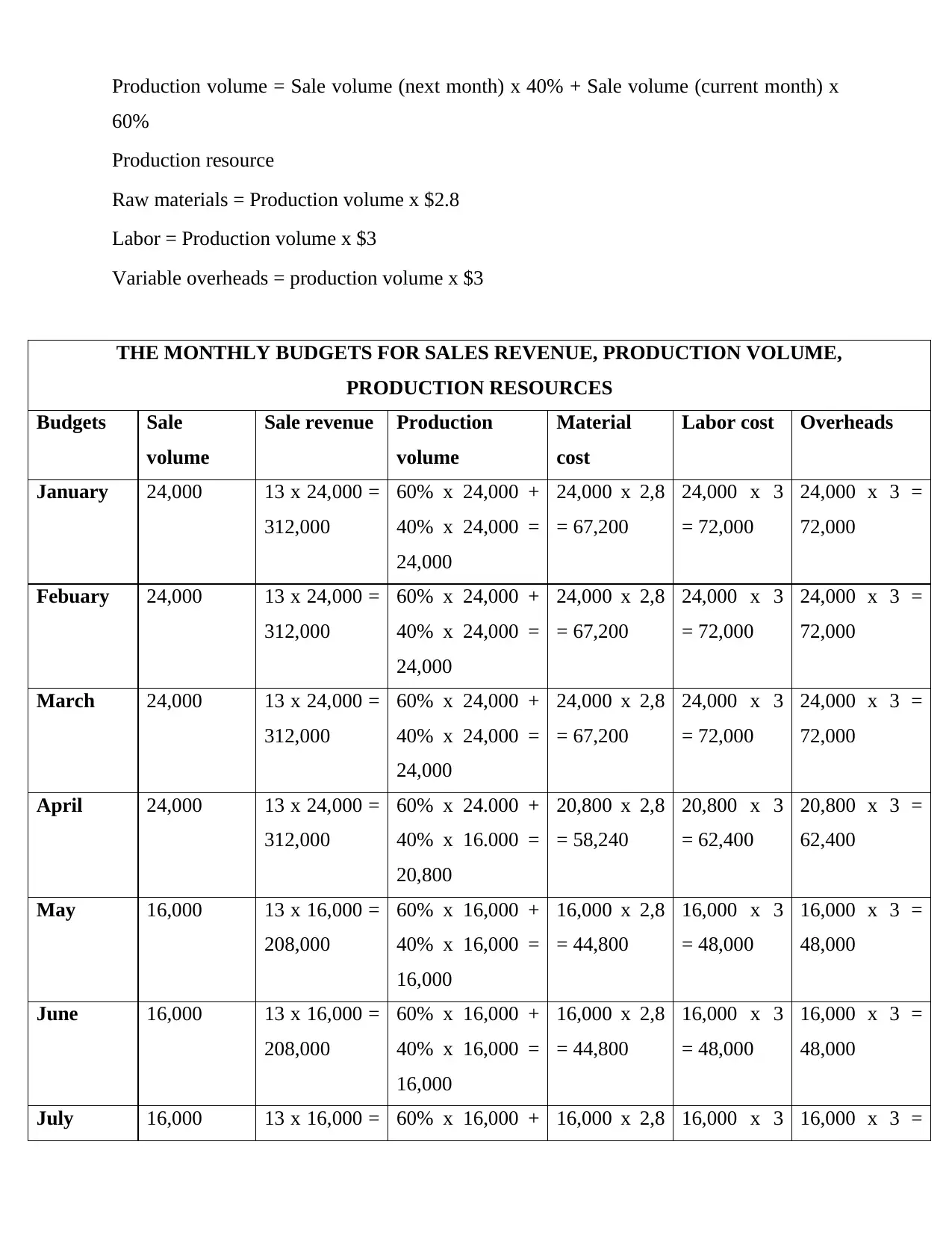
Production volume = Sale volume (next month) x 40% + Sale volume (current month) x
60%
Production resource
Raw materials = Production volume x $2.8
Labor = Production volume x $3
Variable overheads = production volume x $3
THE MONTHLY BUDGETS FOR SALES REVENUE, PRODUCTION VOLUME,
PRODUCTION RESOURCES
Budgets Sale
volume
Sale revenue Production
volume
Material
cost
Labor cost Overheads
January 24,000 13 x 24,000 =
312,000
60% x 24,000 +
40% x 24,000 =
24,000
24,000 x 2,8
= 67,200
24,000 x 3
= 72,000
24,000 x 3 =
72,000
Febuary 24,000 13 x 24,000 =
312,000
60% x 24,000 +
40% x 24,000 =
24,000
24,000 x 2,8
= 67,200
24,000 x 3
= 72,000
24,000 x 3 =
72,000
March 24,000 13 x 24,000 =
312,000
60% x 24,000 +
40% x 24,000 =
24,000
24,000 x 2,8
= 67,200
24,000 x 3
= 72,000
24,000 x 3 =
72,000
April 24,000 13 x 24,000 =
312,000
60% x 24.000 +
40% x 16.000 =
20,800
20,800 x 2,8
= 58,240
20,800 x 3
= 62,400
20,800 x 3 =
62,400
May 16,000 13 x 16,000 =
208,000
60% x 16,000 +
40% x 16,000 =
16,000
16,000 x 2,8
= 44,800
16,000 x 3
= 48,000
16,000 x 3 =
48,000
June 16,000 13 x 16,000 =
208,000
60% x 16,000 +
40% x 16,000 =
16,000
16,000 x 2,8
= 44,800
16,000 x 3
= 48,000
16,000 x 3 =
48,000
July 16,000 13 x 16,000 = 60% x 16,000 + 16,000 x 2,8 16,000 x 3 16,000 x 3 =
60%
Production resource
Raw materials = Production volume x $2.8
Labor = Production volume x $3
Variable overheads = production volume x $3
THE MONTHLY BUDGETS FOR SALES REVENUE, PRODUCTION VOLUME,
PRODUCTION RESOURCES
Budgets Sale
volume
Sale revenue Production
volume
Material
cost
Labor cost Overheads
January 24,000 13 x 24,000 =
312,000
60% x 24,000 +
40% x 24,000 =
24,000
24,000 x 2,8
= 67,200
24,000 x 3
= 72,000
24,000 x 3 =
72,000
Febuary 24,000 13 x 24,000 =
312,000
60% x 24,000 +
40% x 24,000 =
24,000
24,000 x 2,8
= 67,200
24,000 x 3
= 72,000
24,000 x 3 =
72,000
March 24,000 13 x 24,000 =
312,000
60% x 24,000 +
40% x 24,000 =
24,000
24,000 x 2,8
= 67,200
24,000 x 3
= 72,000
24,000 x 3 =
72,000
April 24,000 13 x 24,000 =
312,000
60% x 24.000 +
40% x 16.000 =
20,800
20,800 x 2,8
= 58,240
20,800 x 3
= 62,400
20,800 x 3 =
62,400
May 16,000 13 x 16,000 =
208,000
60% x 16,000 +
40% x 16,000 =
16,000
16,000 x 2,8
= 44,800
16,000 x 3
= 48,000
16,000 x 3 =
48,000
June 16,000 13 x 16,000 =
208,000
60% x 16,000 +
40% x 16,000 =
16,000
16,000 x 2,8
= 44,800
16,000 x 3
= 48,000
16,000 x 3 =
48,000
July 16,000 13 x 16,000 = 60% x 16,000 + 16,000 x 2,8 16,000 x 3 16,000 x 3 =
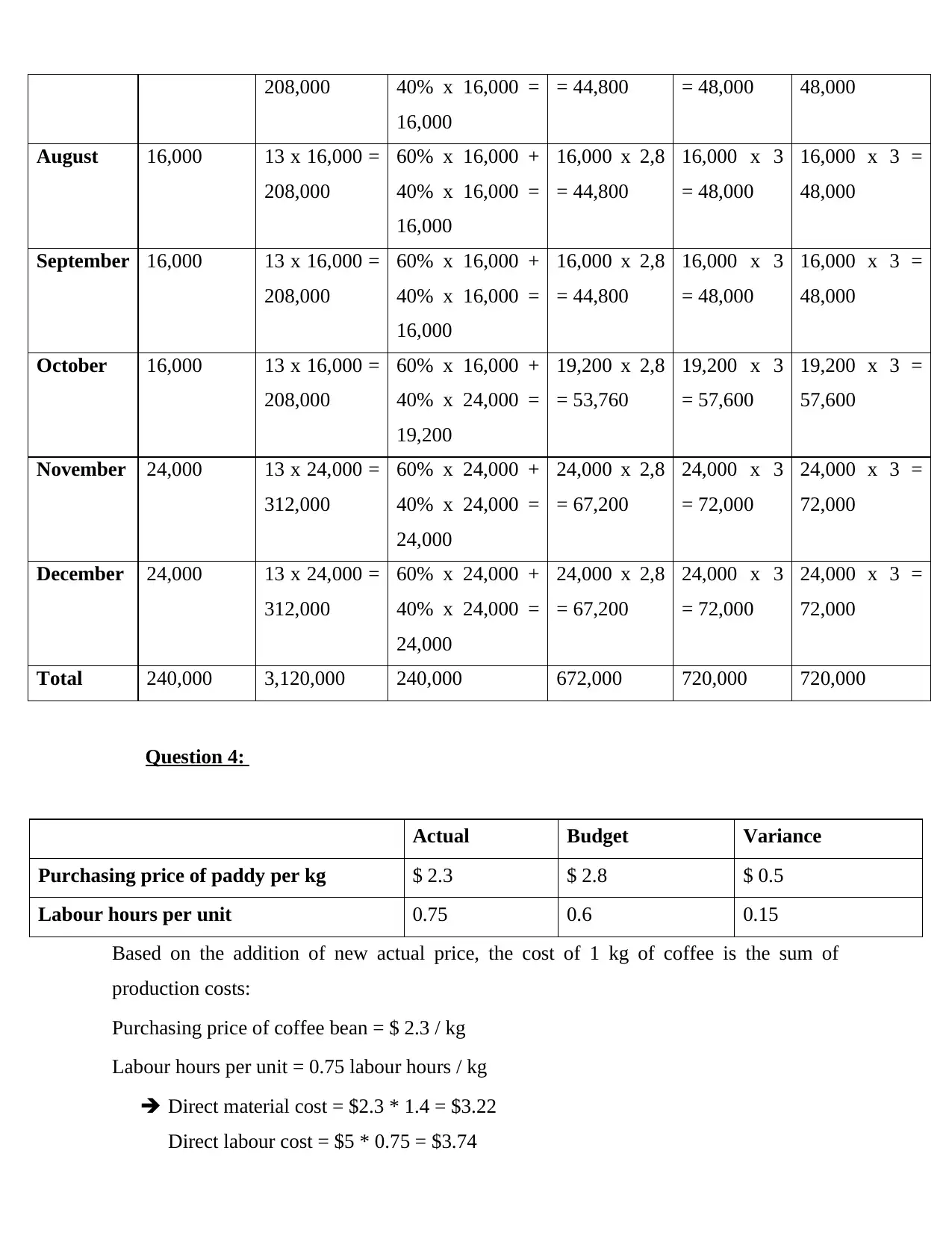
208,000 40% x 16,000 =
16,000
= 44,800 = 48,000 48,000
August 16,000 13 x 16,000 =
208,000
60% x 16,000 +
40% x 16,000 =
16,000
16,000 x 2,8
= 44,800
16,000 x 3
= 48,000
16,000 x 3 =
48,000
September 16,000 13 x 16,000 =
208,000
60% x 16,000 +
40% x 16,000 =
16,000
16,000 x 2,8
= 44,800
16,000 x 3
= 48,000
16,000 x 3 =
48,000
October 16,000 13 x 16,000 =
208,000
60% x 16,000 +
40% x 24,000 =
19,200
19,200 x 2,8
= 53,760
19,200 x 3
= 57,600
19,200 x 3 =
57,600
November 24,000 13 x 24,000 =
312,000
60% x 24,000 +
40% x 24,000 =
24,000
24,000 x 2,8
= 67,200
24,000 x 3
= 72,000
24,000 x 3 =
72,000
December 24,000 13 x 24,000 =
312,000
60% x 24,000 +
40% x 24,000 =
24,000
24,000 x 2,8
= 67,200
24,000 x 3
= 72,000
24,000 x 3 =
72,000
Total 240,000 3,120,000 240,000 672,000 720,000 720,000
Question 4:
Actual Budget Variance
Purchasing price of paddy per kg $ 2.3 $ 2.8 $ 0.5
Labour hours per unit 0.75 0.6 0.15
Based on the addition of new actual price, the cost of 1 kg of coffee is the sum of
production costs:
Purchasing price of coffee bean = $ 2.3 / kg
Labour hours per unit = 0.75 labour hours / kg
Direct material cost = $2.3 * 1.4 = $3.22
Direct labour cost = $5 * 0.75 = $3.74
16,000
= 44,800 = 48,000 48,000
August 16,000 13 x 16,000 =
208,000
60% x 16,000 +
40% x 16,000 =
16,000
16,000 x 2,8
= 44,800
16,000 x 3
= 48,000
16,000 x 3 =
48,000
September 16,000 13 x 16,000 =
208,000
60% x 16,000 +
40% x 16,000 =
16,000
16,000 x 2,8
= 44,800
16,000 x 3
= 48,000
16,000 x 3 =
48,000
October 16,000 13 x 16,000 =
208,000
60% x 16,000 +
40% x 24,000 =
19,200
19,200 x 2,8
= 53,760
19,200 x 3
= 57,600
19,200 x 3 =
57,600
November 24,000 13 x 24,000 =
312,000
60% x 24,000 +
40% x 24,000 =
24,000
24,000 x 2,8
= 67,200
24,000 x 3
= 72,000
24,000 x 3 =
72,000
December 24,000 13 x 24,000 =
312,000
60% x 24,000 +
40% x 24,000 =
24,000
24,000 x 2,8
= 67,200
24,000 x 3
= 72,000
24,000 x 3 =
72,000
Total 240,000 3,120,000 240,000 672,000 720,000 720,000
Question 4:
Actual Budget Variance
Purchasing price of paddy per kg $ 2.3 $ 2.8 $ 0.5
Labour hours per unit 0.75 0.6 0.15
Based on the addition of new actual price, the cost of 1 kg of coffee is the sum of
production costs:
Purchasing price of coffee bean = $ 2.3 / kg
Labour hours per unit = 0.75 labour hours / kg
Direct material cost = $2.3 * 1.4 = $3.22
Direct labour cost = $5 * 0.75 = $3.74
⊘ This is a preview!⊘
Do you want full access?
Subscribe today to unlock all pages.

Trusted by 1+ million students worldwide
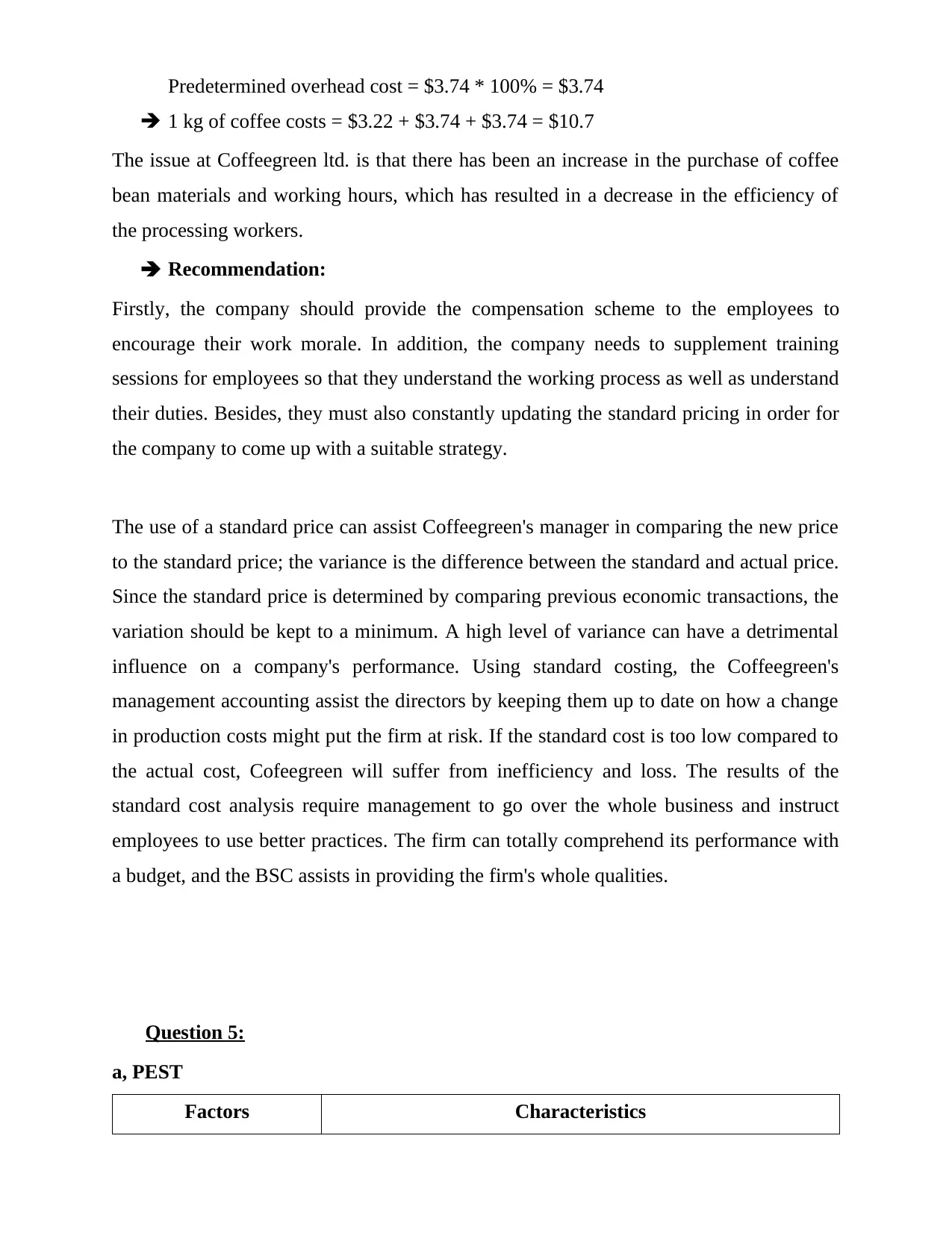
Predetermined overhead cost = $3.74 * 100% = $3.74
1 kg of coffee costs = $3.22 + $3.74 + $3.74 = $10.7
The issue at Coffeegreen ltd. is that there has been an increase in the purchase of coffee
bean materials and working hours, which has resulted in a decrease in the efficiency of
the processing workers.
Recommendation:
Firstly, the company should provide the compensation scheme to the employees to
encourage their work morale. In addition, the company needs to supplement training
sessions for employees so that they understand the working process as well as understand
their duties. Besides, they must also constantly updating the standard pricing in order for
the company to come up with a suitable strategy.
The use of a standard price can assist Coffeegreen's manager in comparing the new price
to the standard price; the variance is the difference between the standard and actual price.
Since the standard price is determined by comparing previous economic transactions, the
variation should be kept to a minimum. A high level of variance can have a detrimental
influence on a company's performance. Using standard costing, the Coffeegreen's
management accounting assist the directors by keeping them up to date on how a change
in production costs might put the firm at risk. If the standard cost is too low compared to
the actual cost, Cofeegreen will suffer from inefficiency and loss. The results of the
standard cost analysis require management to go over the whole business and instruct
employees to use better practices. The firm can totally comprehend its performance with
a budget, and the BSC assists in providing the firm's whole qualities.
Question 5:
a, PEST
Factors Characteristics
1 kg of coffee costs = $3.22 + $3.74 + $3.74 = $10.7
The issue at Coffeegreen ltd. is that there has been an increase in the purchase of coffee
bean materials and working hours, which has resulted in a decrease in the efficiency of
the processing workers.
Recommendation:
Firstly, the company should provide the compensation scheme to the employees to
encourage their work morale. In addition, the company needs to supplement training
sessions for employees so that they understand the working process as well as understand
their duties. Besides, they must also constantly updating the standard pricing in order for
the company to come up with a suitable strategy.
The use of a standard price can assist Coffeegreen's manager in comparing the new price
to the standard price; the variance is the difference between the standard and actual price.
Since the standard price is determined by comparing previous economic transactions, the
variation should be kept to a minimum. A high level of variance can have a detrimental
influence on a company's performance. Using standard costing, the Coffeegreen's
management accounting assist the directors by keeping them up to date on how a change
in production costs might put the firm at risk. If the standard cost is too low compared to
the actual cost, Cofeegreen will suffer from inefficiency and loss. The results of the
standard cost analysis require management to go over the whole business and instruct
employees to use better practices. The firm can totally comprehend its performance with
a budget, and the BSC assists in providing the firm's whole qualities.
Question 5:
a, PEST
Factors Characteristics
Paraphrase This Document
Need a fresh take? Get an instant paraphrase of this document with our AI Paraphraser
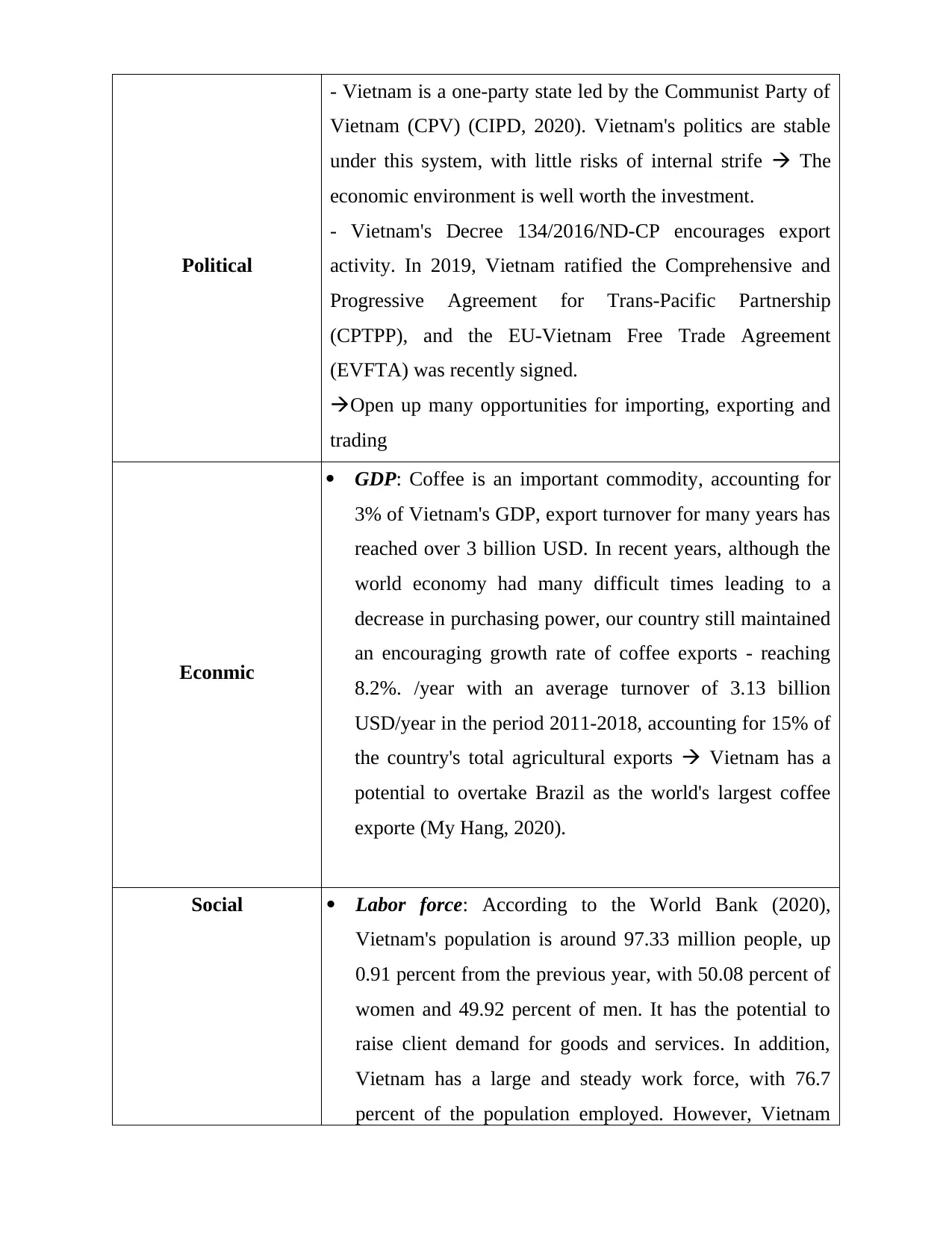
Political
- Vietnam is a one-party state led by the Communist Party of
Vietnam (CPV) (CIPD, 2020). Vietnam's politics are stable
under this system, with little risks of internal strife The
economic environment is well worth the investment.
- Vietnam's Decree 134/2016/ND-CP encourages export
activity. In 2019, Vietnam ratified the Comprehensive and
Progressive Agreement for Trans-Pacific Partnership
(CPTPP), and the EU-Vietnam Free Trade Agreement
(EVFTA) was recently signed.
Open up many opportunities for importing, exporting and
trading
Econmic
GDP: Coffee is an important commodity, accounting for
3% of Vietnam's GDP, export turnover for many years has
reached over 3 billion USD. In recent years, although the
world economy had many difficult times leading to a
decrease in purchasing power, our country still maintained
an encouraging growth rate of coffee exports - reaching
8.2%. /year with an average turnover of 3.13 billion
USD/year in the period 2011-2018, accounting for 15% of
the country's total agricultural exports Vietnam has a
potential to overtake Brazil as the world's largest coffee
exporte (My Hang, 2020).
Social Labor force: According to the World Bank (2020),
Vietnam's population is around 97.33 million people, up
0.91 percent from the previous year, with 50.08 percent of
women and 49.92 percent of men. It has the potential to
raise client demand for goods and services. In addition,
Vietnam has a large and steady work force, with 76.7
percent of the population employed. However, Vietnam
- Vietnam is a one-party state led by the Communist Party of
Vietnam (CPV) (CIPD, 2020). Vietnam's politics are stable
under this system, with little risks of internal strife The
economic environment is well worth the investment.
- Vietnam's Decree 134/2016/ND-CP encourages export
activity. In 2019, Vietnam ratified the Comprehensive and
Progressive Agreement for Trans-Pacific Partnership
(CPTPP), and the EU-Vietnam Free Trade Agreement
(EVFTA) was recently signed.
Open up many opportunities for importing, exporting and
trading
Econmic
GDP: Coffee is an important commodity, accounting for
3% of Vietnam's GDP, export turnover for many years has
reached over 3 billion USD. In recent years, although the
world economy had many difficult times leading to a
decrease in purchasing power, our country still maintained
an encouraging growth rate of coffee exports - reaching
8.2%. /year with an average turnover of 3.13 billion
USD/year in the period 2011-2018, accounting for 15% of
the country's total agricultural exports Vietnam has a
potential to overtake Brazil as the world's largest coffee
exporte (My Hang, 2020).
Social Labor force: According to the World Bank (2020),
Vietnam's population is around 97.33 million people, up
0.91 percent from the previous year, with 50.08 percent of
women and 49.92 percent of men. It has the potential to
raise client demand for goods and services. In addition,
Vietnam has a large and steady work force, with 76.7
percent of the population employed. However, Vietnam
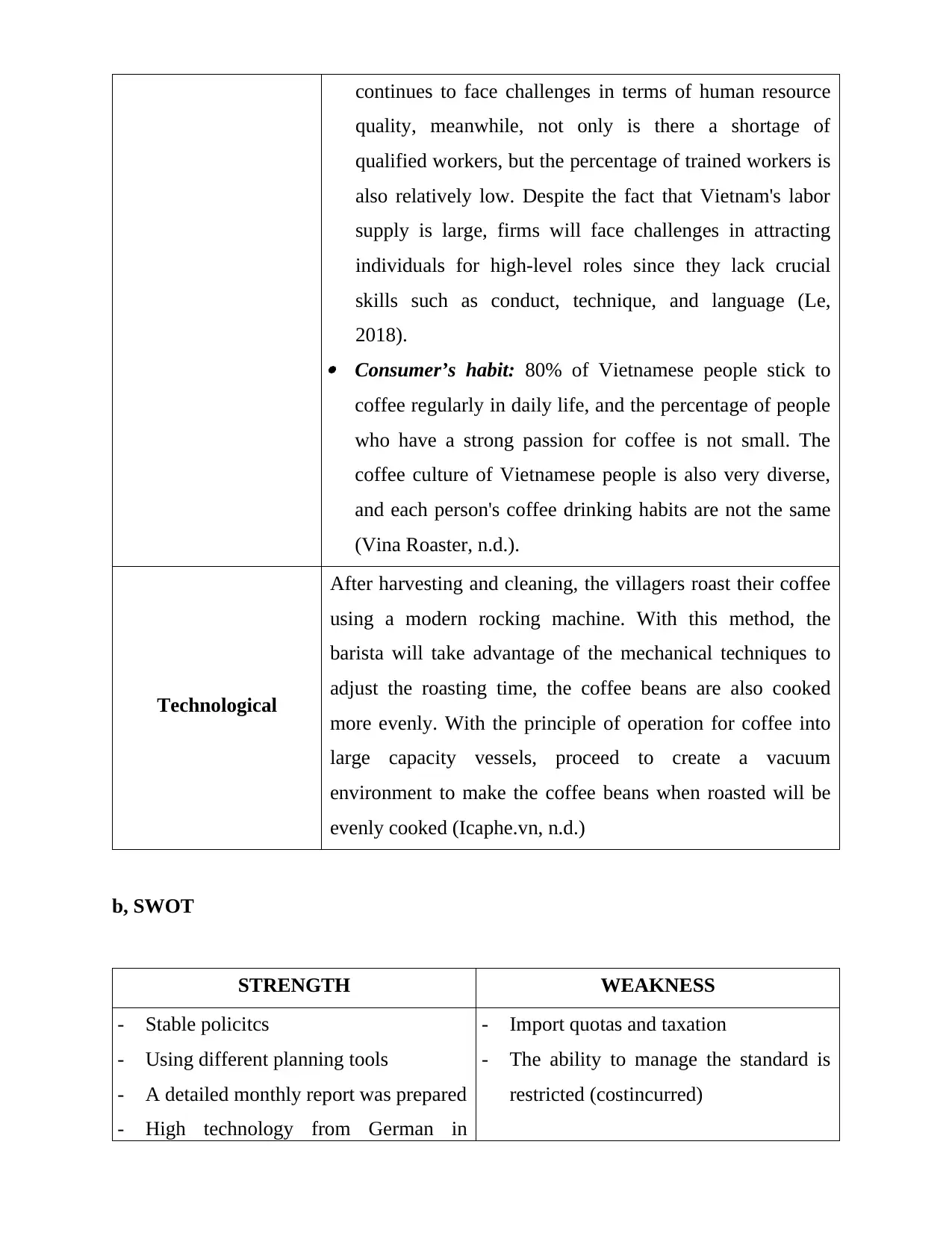
continues to face challenges in terms of human resource
quality, meanwhile, not only is there a shortage of
qualified workers, but the percentage of trained workers is
also relatively low. Despite the fact that Vietnam's labor
supply is large, firms will face challenges in attracting
individuals for high-level roles since they lack crucial
skills such as conduct, technique, and language (Le,
2018).
Consumer’s habit: 80% of Vietnamese people stick to
coffee regularly in daily life, and the percentage of people
who have a strong passion for coffee is not small. The
coffee culture of Vietnamese people is also very diverse,
and each person's coffee drinking habits are not the same
(Vina Roaster, n.d.).
Technological
After harvesting and cleaning, the villagers roast their coffee
using a modern rocking machine. With this method, the
barista will take advantage of the mechanical techniques to
adjust the roasting time, the coffee beans are also cooked
more evenly. With the principle of operation for coffee into
large capacity vessels, proceed to create a vacuum
environment to make the coffee beans when roasted will be
evenly cooked (Icaphe.vn, n.d.)
b, SWOT
STRENGTH WEAKNESS
- Stable policitcs
- Using different planning tools
- A detailed monthly report was prepared
- High technology from German in
- Import quotas and taxation
- The ability to manage the standard is
restricted (costincurred)
quality, meanwhile, not only is there a shortage of
qualified workers, but the percentage of trained workers is
also relatively low. Despite the fact that Vietnam's labor
supply is large, firms will face challenges in attracting
individuals for high-level roles since they lack crucial
skills such as conduct, technique, and language (Le,
2018).
Consumer’s habit: 80% of Vietnamese people stick to
coffee regularly in daily life, and the percentage of people
who have a strong passion for coffee is not small. The
coffee culture of Vietnamese people is also very diverse,
and each person's coffee drinking habits are not the same
(Vina Roaster, n.d.).
Technological
After harvesting and cleaning, the villagers roast their coffee
using a modern rocking machine. With this method, the
barista will take advantage of the mechanical techniques to
adjust the roasting time, the coffee beans are also cooked
more evenly. With the principle of operation for coffee into
large capacity vessels, proceed to create a vacuum
environment to make the coffee beans when roasted will be
evenly cooked (Icaphe.vn, n.d.)
b, SWOT
STRENGTH WEAKNESS
- Stable policitcs
- Using different planning tools
- A detailed monthly report was prepared
- High technology from German in
- Import quotas and taxation
- The ability to manage the standard is
restricted (costincurred)
⊘ This is a preview!⊘
Do you want full access?
Subscribe today to unlock all pages.

Trusted by 1+ million students worldwide
1 out of 21
Related Documents
Your All-in-One AI-Powered Toolkit for Academic Success.
+13062052269
info@desklib.com
Available 24*7 on WhatsApp / Email
![[object Object]](/_next/static/media/star-bottom.7253800d.svg)
Unlock your academic potential
Copyright © 2020–2025 A2Z Services. All Rights Reserved. Developed and managed by ZUCOL.





